 W
WA dwarf galaxy is a small galaxy composed of about 1000 up to several billion stars, as compared to the Milky Way's 200–400 billion stars. The Large Magellanic Cloud, which closely orbits the Milky Way and contains over 30 billion stars, is sometimes classified as a dwarf galaxy; others consider it a full-fledged galaxy. Dwarf galaxies' formation and activity are thought to be heavily influenced by interactions with larger galaxies. Astronomers identify numerous types of dwarf galaxies, based on their shape and composition.
 W
WA dwarf spheroidal galaxy (dSph) is a term in astronomy applied to small, low-luminosity galaxies with very little dust and an older stellar population. They are found in the Local Group as companions to the Milky Way and to systems that are companions to the Andromeda Galaxy (M31). While similar to dwarf elliptical galaxies in appearance and properties such as little to no gas or dust or recent star formation, they are approximately spheroidal in shape and generally have lower luminosity.
 W
WA dwarf spiral galaxy is the dwarf version of a spiral galaxy. Dwarf galaxies are characterized as having low luminosities, small diameters, low surface brightnesses, and low hydrogen masses. The galaxies may be considered a subclass of low-surface-brightness galaxies.
 W
WA1689-zD1 is a galaxy in the Virgo constellation cluster. It was a candidate for the most distant and therefore earliest-observed galaxy discovered as of February 2008, based on a photometric redshift.
 W
WAbell 1835 IR1916 was a candidate for being the most distant galaxy ever observed, although that claim has not been verified by additional observations. It was claimed to lie behind the galaxy cluster Abell 1835, in the Virgo constellation.
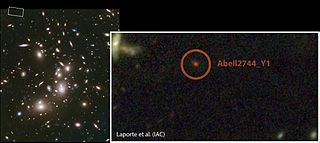 W
WAbell 2744 Y1 is a galaxy located in the Abell 2744 galaxy cluster, 13 billion light years away in the Sculptor constellation. It is 2,300 light years in diameter, 50 times smaller than the Milky Way galaxy, but producing 10 times more stars. The galaxy was discovered in July 2014 by an international team led by astronomers from the Instituto de Astrofísica de Canarias (IAC) and La Laguna University (ULL) as part of the Frontier Fields program with the help of NASA’s Spitzer and Hubble Space Telescopes.
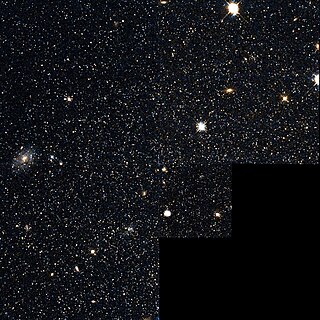 W
WAndromeda I is a dwarf spheroidal galaxy (dSph) about 2.40 million light-years away in the constellation Andromeda. Andromeda I is part of the local group of galaxies and a satellite galaxy of the Andromeda Galaxy (M31). It is roughly 3.5 degrees south and slightly east of M31. As of 2005, it is the closest known dSph companion to M31 at an estimated projected distance of ~40 kpc or ~150,000 light-years.
 W
WThe Cassiopeia Dwarf is a dwarf spheroidal galaxy about 2.58 Mly away in the constellation Cassiopeia. The Cassiopeia Dwarf is part of the Local Group and a satellite galaxy of the Andromeda Galaxy (M31).
 W
WDDO 190 is a dwarf irregular galaxy in the vicinity of the Milky Way, as it is relatively small and lacks clear structure. It is 9.10 million light-years (2.79 Mpc) away from Earth and lies out of the Local Group, determined by the tip of the red giant branch method. The outskirts of the galaxy are harbouring older (reddish) stars, while the centre is crowded with younger (bluish) stars. Heated gas is observed at several places. DDO 190 still experiences some active star formation. The galaxy is categorised as a Magellanic dwarf galaxy of morphological type Im. Its metallicity is [Fe/H] = −1.55 ± 0.12.
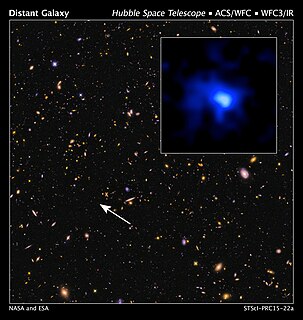 W
WEGS-zs8-1 is a high-redshift Lyman-break galaxy found at the northern constellation of Boötes. In May 2015, EGS-zs8-1 had the highest spectroscopic redshift of any known galaxy, meaning EGS-zs8-1 was the most distant and the oldest galaxy observed. In July 2015, EGS-zs8-1 was surpassed by EGSY8p7 (EGSY-2008532660).
 W
WESO 540-030 is a faint dwarf galaxy in the Sculptor Group. It has the appearance of a massive scattering of dim stars.
 W
WThe Fornax Dwarf Spheroidal is an elliptical dwarf galaxy in the constellation Fornax that was discovered in 1938 by Harlow Shapley. He discovered it while he was in South Africa on photographic plates taken by the 24 inch (61 cm) Bruce refractor at Boyden Observatory, shortly after he discovered the Sculptor Dwarf Galaxy.
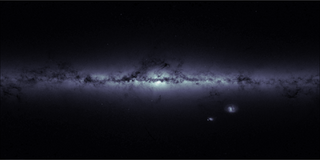 W
WThe Gaia Sausage is the remains of a dwarf galaxy, the Sausage Galaxy, or Gaia-Enceladus-Sausage, or Gaia-Enceladus, that merged with the Milky Way about 8–11 billion years ago. At least eight globular clusters were added to the Milky Way along with 50 billion solar masses of stars, gas and dark matter.
 W
WHanny's Voorwerp, is a rare type of astronomical object called a quasar ionization echo. It was discovered in 2007 by Dutch schoolteacher Hanny van Arkel while she was participating as a volunteer in the Galaxy Zoo project, part of the Zooniverse group of citizen science websites. Photographically, it appears as a bright blob close to spiral galaxy IC 2497 in the constellation Leo Minor.
 W
WHCM-6A is an LAE galaxy that was found in 2002 by a team led by Esther Hu from the University of Hawaii, using the Keck II Telescope in Hawaii. HCM-6A is located behind the Abell 370 galactic cluster, near M77 in the constellation Cetus, which enabled the astronomers to use Abell 370 as a gravitational lens to get a clearer image of the object.
 W
WHen 2-10, also known as He 2-10 and Henize 2-10, is a dwarf starburst galaxy located 34 million light years away in the constellation of Pyxis. The galaxy is believed to be an early stage starburst galaxy. A black hole was later discovered near the center of the dwarf galaxy, suggesting that the black holes found at the center of most large galaxies may have formed before the galaxies themselves. Recent estimates have placed the mass of this black hole around 3×106 M☉, and the mass of the entire dwarf galaxy at about 1×1010 M☉.
 W
WHolmberg II is a dwarf galaxy in the constellation Ursa Major. Its apparent magnitude is 11,1m and it is 11 million light years away from Earth. The galaxy is dominated by huge glowing gas bubbles, which are regions of star formation.
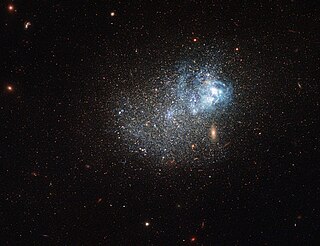 W
WI Zwicky 36, often abbreviated to I Zw 36, is a blue compact dwarf galaxy which is in the constellation Canes Venatici. The dominant population of stars in I Zw 36 is young in stellar terms, with ages of under 3 million years.
 W
WLEDA 2108986, also known by its Case Western Reserve University designation "Case Galaxy 611", is an extremely isolated, early-type dwarf galaxy with an embedded spiral structure residing in what is likely an intermediate-scale disk. The galaxy was discovered in 1987 by Sanduleak and Pesch, and is located at a distance of about 45.7 megaparsecs (149,000,000 ly) in the Boötes void and has no significant neighbours within 2.5 Mpc.
 W
WLeo A (also known as Leo III) is an irregular galaxy that is part of the Local Group. It lies 2.6 million light-years from Earth, and was discovered by Fritz Zwicky in 1942. The estimated mass of this galaxy is (8.0 ± 2.7) × 107 solar masses, with at least 80% consisting of an unknown dark matter. It is one of the most isolated galaxies in the Local Group and shows no indications of an interaction or merger for several billion years. However, Leo A is nearly unique among irregular galaxies in that more than 90% of its stars formed more recently than 8 billion years ago, suggesting a rather unusual evolutionary history. The presence of RR Lyrae variables shows that the galaxy has an old stellar population that is up to 10 billion years in age.
 W
WThis is a list of stellar streams. A stellar stream is an association of stars orbiting a galaxy that was once a globular cluster or dwarf galaxy that has now been torn apart and stretched out along its orbit by tidal forces. A notable exception in the list about Milky Way streams given below is the Magellanic Stream, composed of gas.
 W
WM59-UCD3 is an ultra-compact dwarf galaxy located near the Messier 59 galaxy. As of 2015, it is the second-densest galaxy currently observed, second to M85-HCC1.
 W
WM60-UCD1 is an ultracompact dwarf galaxy. It is 54 million light years from Earth, close to Messier 60 in the Virgo Cluster. Half of its stellar mass is in the central sphere 160 light years in diameter.
 W
WM85-HCC1 is an ultracompact dwarf galaxy with a star density 1,000,000 times that of the solar neighbourhood, lying near the galaxy Messier 85. As of 2015, it is the densest galaxy known.
MACS0647-JD is the farthest known galaxy from the Earth based on the photometric redshift. It has a redshift of about z = 10.7, equivalent to a light travel distance of 13.26 billion light-years. If the distance estimate is correct, it formed about 427 million years after the Big Bang.
 W
WMACS1149-JD1 is one of the farthest known galaxies from Earth and is at a redshift of about z=9.11, or about 13.28 billion ly (4.07 billion pc) light-travel distance. It is one percent of the Milky Way's mass.
 W
WMessier 32 is a dwarf "early-type" galaxy located about 2.65 million light-years from Earth, appearing in the constellation Andromeda. M32 is a satellite galaxy of the Andromeda Galaxy (M31) and was discovered by Guillaume Le Gentil in 1749. M32 measures 6.5 ± 0.2 thousand light-years in diameter at the widest point.
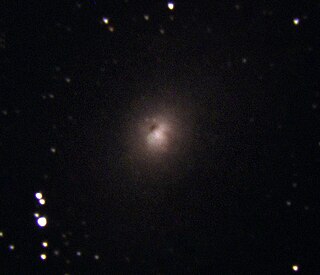 W
WNGC 185 is a dwarf spheroidal galaxy located 2.08 million light-years from Earth, appearing in the constellation Cassiopeia. It is a member of the Local Group, and is a satellite of the Andromeda Galaxy (M31). NGC 185 was discovered by William Herschel on November 30, 1787, and he cataloged it "H II.707". John Herschel observed the object again in 1833 when he cataloged it as "h 35", and then in 1864 when he cataloged it as "GC 90" within his General Catalogue of Nebulae and Clusters. NGC 185 was first photographed between 1898 and 1900 by James Edward Keeler with the Crossley Reflector of Lick Observatory. Unlike most dwarf elliptical galaxies, NGC 185 contains young stellar clusters, and star formation proceeded at a low rate until the recent past. NGC 185 has an active galactic nucleus (AGN) and is usually classified as a type 2 Seyfert galaxy, though its status as a Seyfert is questioned. It is possibly the closest Seyfert galaxy to Earth, and is the only known Seyfert in the Local Group.
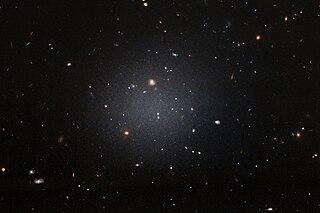 W
WNGC 1052-DF2 is an ultra diffuse galaxy in the constellation Cetus, which was identified in a wide-field imaging survey of the NGC 1052 group by the Dragonfly Telephoto Array. It has been proposed that the galaxy contains little or no dark matter, the first such discovery. On 20 March 2019, a follow-up study announcing the discovery of a second UDG lacking dark matter, NGC 1052-DF4, was published.
 W
WNGC 1510 is a dwarf lenticular galaxy approximately 38 million light-years away from Earth in the constellation of Horologium. It was discovered by John Herschel on December 4, 1836.
 W
WNGC 1531 is a dwarf galaxy in the constellation Eridanus that is interacting with the larger spiral galaxy NGC 1532. It was discovered by John Herschel on 19 October 1835. Although technically classified as a peculiar lenticular galaxy, the galaxy's structure is better described as amorphous.
 W
WNGC 2976 is a peculiar dwarf galaxy in the northern circumpolar constellation of Ursa Major. It was discovered by German-born astronomer William Herschel on November 8, 1801, and catalogued as H I.285. J. L. E. Dreyer described it as, "bright, very large, much extended 152°, star involved". It is a member of the M81 Group and lies 1° 20′ to the southwest of Messier 81. The projected separation of this galaxy from the M81 Group is 190 kpc.
 W
WNGC 3738 is a dwarf galaxy in the constellation of Ursa Major and belongs to the M81 Group of galaxies. NGC 3738 is 12 million light-years from the sun. The galaxy was first discovered by astronomer William Herschel in 1789. NGC 3738 is a blue compact dwarf, which is small compared to large spiral galaxies. The galaxy is about 10,000 light-years across. It is one-tenth the size of the Milky Way
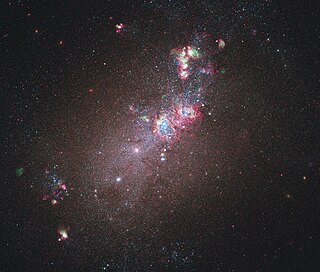 W
WNGC 4214 is a dwarf barred irregular galaxy located around 10 million light-years away in the constellation Canes Venatici. NGC 4214 is a member of the M94 Group.
 W
WNGC 4306 is a dwarf barred lenticular galaxy located about 100 million light-years away in the constellation Virgo. The galaxy was discovered by astronomer Heinrich d'Arrest on April 16, 1865.
 W
WNGC 5474 is a peculiar dwarf galaxy in the constellation Ursa Major. It is one of several companion galaxies of the Pinwheel Galaxy (M101), a grand-design spiral galaxy. Among the Pinwheel Galaxy's companions, this galaxy is the closest to the Pinwheel Galaxy itself. The gravitational interaction between NGC 5474 and the Pinwheel Galaxy has strongly distorted the former. As a result, the disk is offset relative to the nucleus. The star formation in this galaxy is also offset from the nucleus. NGC 5474 shows some signs of a spiral structure. As a result, this galaxy is often classified as a dwarf spiral galaxy, a relatively rare group of dwarf galaxies.
 W
WNGC 5477 is a dwarf galaxy located in the constellation of Ursa Major, 20 million light years away from Earth.
 W
WPGC 39058 is a dwarf galaxy located 14 million light-years away in the constellation Draco. The galaxy is faint and obscured by HD 106381, a star in the foreground making it difficult to observe.
 W
WPHL 293B, also known as Kinman's dwarf, is a low-metallicity blue compact dwarf galaxy about 22.6 Mpc from the Earth in the constellation Aquarius.
 W
WPisces A is a void dwarf galaxy. It is located in the Local Void, near Pisces B; and is in the Pisces constellation. It is 18.4 million light-years away from Earth. The galaxy was discovered with the WIYN Observatory. About 100 million years ago, the galaxy started moving out of the void and into the local filament zone and denser gaseous environment. This sparked off a doubling of the rate of star formation.
 W
WPisces B is a void dwarf galaxy. It is located in the Local Void, near Pisces A; and is in the Pisces constellation. It is 30 million light-years away from the Earth. The galaxy was discovered with the WIYN Observatory. About 100 million years ago, the galaxy started moving out of the void and into the local filament zone and denser gaseous environment. This sparked off a doubling of the rate of star formation.
 W
WThe Sagittarius Dwarf Spheroidal Galaxy (Sgr dSph), also known as the Sagittarius Dwarf Elliptical Galaxy, is an elliptical loop-shaped satellite galaxy of the Milky Way. It contains four globular clusters, with the brightest of them – NGC 6715 (M54) – being known well before the discovery of the galaxy itself in 1994. Sgr dSph is roughly 10,000 light-years in diameter, and is currently about 70,000 light-years from Earth, travelling in a polar orbit at a distance of about 50,000 light-years from the core of the Milky Way. In its looping, spiraling path, it has passed through the plane of the Milky Way several times in the past. In 2018 the Gaia project of the European Space Agency showed that Sgr dSph had caused perturbations in a set of stars near the Milky Way's core, causing unexpected rippling movements of the stars triggered when it moved past the Milky Way between 300 and 900 million years ago.
 W
WSextans A is a tiny dwarf irregular galaxy. It spans about 5000 light-years across, and is located at 4.3 million light-years away, in the outskirts of the Local Group of galaxies, which includes the Milky Way galaxy, and to which Sextans A may or may not belong.
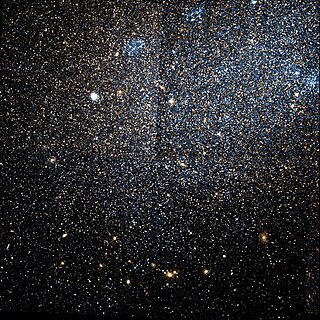 W
WSextans B is an irregular galaxy that may be part of the Local Group, or lie just beyond it. Sextans B is 4.44 million light-years away from Earth and thus is one of the most distant members of the Local Group, if it is indeed a member. It forms a pair with its neighbouring galaxy Sextans A. It is a type Ir IV-V galaxy according to the galaxy morphological classification scheme. Sextans B may also be gravitationally associated with the galaxies NGC 3109 and the Antlia Dwarf.
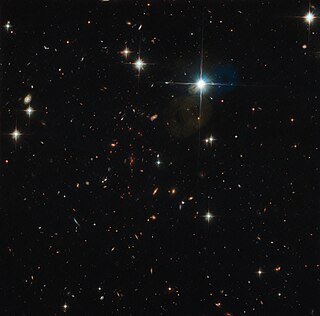 W
WSPT0615-JD is a dwarf galaxy situated within the constellation Pictor, and is the farthest galaxy ever imaged by means of gravitational lensing, as of 2018. Brett Salmon of the Space Telescope Science Institute in Baltimore was the lead scientist of the study of the galaxy.
 W
WThe Tucana Dwarf Galaxy is a dwarf galaxy in the constellation Tucana. It was discovered in 1990 by R.J. Lavery of Mount Stromlo Observatory. It is composed of very old stars and is very isolated from other galaxies. Its location on the opposite side of the Milky Way from other Local Group galaxies makes it an important object for study.
 W
WUDFj-39546284 is the designation given to a stellar structure reported on January 27, 2011, as light from the oldest object detected through infrared observation within the Hubble Space Telescope. The object, located in the Fornax constellation, was identified by G. Illingworth, R. Bouwens and the HUDF09 Team during 2009 and 2010. It was initially thought to be at redshift z~10 using Hubble and Spitzer telescope photometric data, including Hubble Extreme Deep Field (XDF). Subsequently, it was reported to possibly be at a record-breaking redshift z = 11.9 using Hubble and Spitzer telescope data, including Hubble Ultra-Deep Field (HUDF). Recent analyses have suggested this source is more likely to be a low redshift interloper, with extreme emission lines in its spectrum producing the appearance of a very high redshift source.
 W
WUDFy-38135539 is the Hubble Ultra Deep Field (UDF) identifier for a galaxy which was calculated as of October 2010 to have a light travel time of 13.1 billion years with a present proper distance of around 30 billion light-years.
 W
WUGC 4879, which is also known as VV 124, is the most isolated dwarf galaxy in the periphery of the Local Group. It is an irregular galaxy at a distance of 1.38 Mpc. Low-resolution spectroscopy yielded inconsistent radial velocities for different components of the galaxy, hinting at the presence of a stellar disk. There is also evidence of this galaxy containing dark matter.
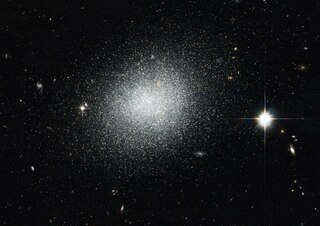 W
WUGC 5497 is a dwarf galaxy, located about 12 million light years away in the constellation Ursa Major. It is a member of the M81 Group.
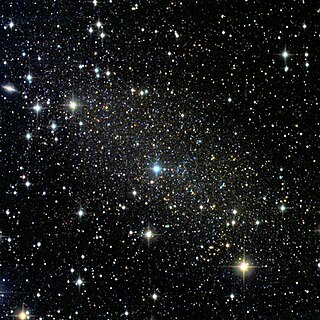 W
WThe Ursa Minor Dwarf is a dwarf spheroidal galaxy, discovered by A.G. Wilson of the Lowell Observatory, in the United States, during the Palomar Sky Survey in 1955. It appears in the Ursa Minor constellation, and is a satellite galaxy of the Milky Way. The galaxy consists mainly of older stars and seems to house little to no ongoing star formation. Its centre is around 225,000 light years distant from Earth.
 W
Wz8_GND_5296 is a dwarf galaxy discovered in October 2013 which has the highest redshift that has been confirmed through the Lyman-alpha emission line of hydrogen, placing it among the oldest and most distant known galaxies at approximately 13.1 billion light-years (4.0 Gpc) from Earth. It is "seen as it was at a time just 700 million years after the Big Bang [...] when the universe was only about 5 percent of its current age of 13.8 billion years". The galaxy is at a redshift of 7.51, and it is a neighbour to what was announced then as the second-most distant galaxy with a redshift of 7.2. The galaxy in its observable timeframe was producing stars at a phenomenal rate, equivalent in mass to about 330 Suns per year.